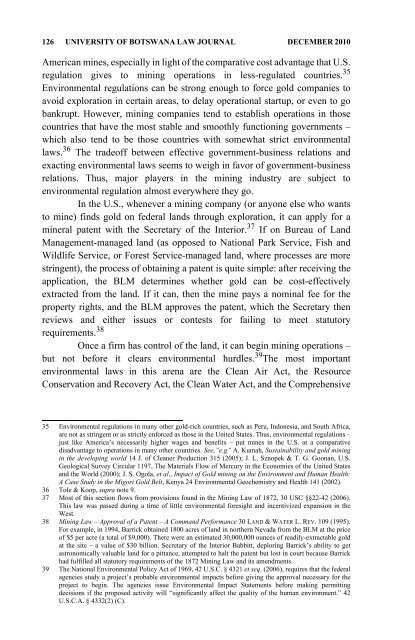University of Botswana Law Journal - PULP
University of Botswana Law Journal - PULP
University of Botswana Law Journal - PULP
You also want an ePaper? Increase the reach of your titles
YUMPU automatically turns print PDFs into web optimized ePapers that Google loves.
126 UNIVERSITY OF BOTSWANA LAW JOURNAL DECEMBER 2010<br />
American mines, especially in light <strong>of</strong> the comparative cost advantage that U.S.<br />
regulation gives to mining operations in less-regulated countries. 35<br />
Environmental regulations can be strong enough to force gold companies to<br />
avoid exploration in certain areas, to delay operational startup, or even to go<br />
bankrupt. However, mining companies tend to establish operations in those<br />
countries that have the most stable and smoothly functioning governments –<br />
which also tend to be those countries with somewhat strict environmental<br />
laws. 36 The trade<strong>of</strong>f between effective government-business relations and<br />
exacting environmental laws seems to weigh in favor <strong>of</strong> government-business<br />
relations. Thus, major players in the mining industry are subject to<br />
environmental regulation almost everywhere they go.<br />
In the U.S., whenever a mining company (or anyone else who wants<br />
to mine) finds gold on federal lands through exploration, it can apply for a<br />
mineral patent with the Secretary <strong>of</strong> the Interior. 37 If on Bureau <strong>of</strong> Land<br />
Management-managed land (as opposed to National Park Service, Fish and<br />
Wildlife Service, or Forest Service-managed land, where processes are more<br />
stringent), the process <strong>of</strong> obtaining a patent is quite simple: after receiving the<br />
application, the BLM determines whether gold can be cost-effectively<br />
extracted from the land. If it can, then the mine pays a nominal fee for the<br />
property rights, and the BLM approves the patent, which the Secretary then<br />
reviews and either issues or contests for failing to meet statutory<br />
requirements. 38<br />
Once a firm has control <strong>of</strong> the land, it can begin mining operations –<br />
but not before it clears environmental hurdles. 39 The most important<br />
environmental laws in this arena are the Clean Air Act, the Resource<br />
Conservation and Recovery Act, the Clean Water Act, and the Comprehensive<br />
35 Environmental regulations in many other gold-rich countries, such as Peru, Indonesia, and South Africa,<br />
are not as stringent or as strictly enforced as those in the United States. Thus, environmental regulations –<br />
just like America’s necessarily higher wages and benefits – put mines in the U.S. at a comparative<br />
disadvantage to operations in many other countries. See,”e.g” A. Kumah, Sustainability and gold mining<br />
in the developing world 14 J. <strong>of</strong> Cleaner Production 315 (2005); J. L. Sznopek & T. G. Goonan, U.S.<br />
Geological Survey Circular 1197, The Materials Flow <strong>of</strong> Mercury in the Economies <strong>of</strong> the United States<br />
and the World (2000); J. S. Ogola, et al., Impact <strong>of</strong> Gold mining on the Environment and Human Health:<br />
A Case Study in the Migori Gold Belt, Kenya 24 Environmental Geochemistry and Health 141 (2002).<br />
36 Tole & Koop, supra note 9.<br />
37 Most <strong>of</strong> this section flows from provisions found in the Mining <strong>Law</strong> <strong>of</strong> 1872, 30 USC §§22-42 (2006).<br />
This law was passed during a time <strong>of</strong> little environmental foresight and incentivized expansion in the<br />
West.<br />
38 Mining <strong>Law</strong> – Approval <strong>of</strong> a Patent – A Command Performance 30 LAND & WATER L. REV. 109 (1995).<br />
For example, in 1994, Barrick obtained 1800 acres <strong>of</strong> land in northern Nevada from the BLM at the price<br />
<strong>of</strong> $5 per acre (a total <strong>of</strong> $9,000). There were an estimated 30,000,000 ounces <strong>of</strong> readily-extractable gold<br />
at the site – a value <strong>of</strong> $30 billion. Secretary <strong>of</strong> the Interior Babbitt, deploring Barrick’s ability to get<br />
astronomically valuable land for a pittance, attempted to halt the patent but lost in court because Barrick<br />
had fulfilled all statutory requirements <strong>of</strong> the 1872 Mining <strong>Law</strong> and its amendments.<br />
39 The National Environmental Policy Act <strong>of</strong> 1969, 42 U.S.C. § 4321 et seq. (2006), requires that the federal<br />
agencies study a project’s probable environmental impacts before giving the approval necessary for the<br />
project to begin. The agencies issue Environmental Impact Statements before making permitting<br />
decisions if the proposed activity will “significantly affect the quality <strong>of</strong> the human environment.” 42<br />
U.S.C.A. § 4332(2) (C).
















